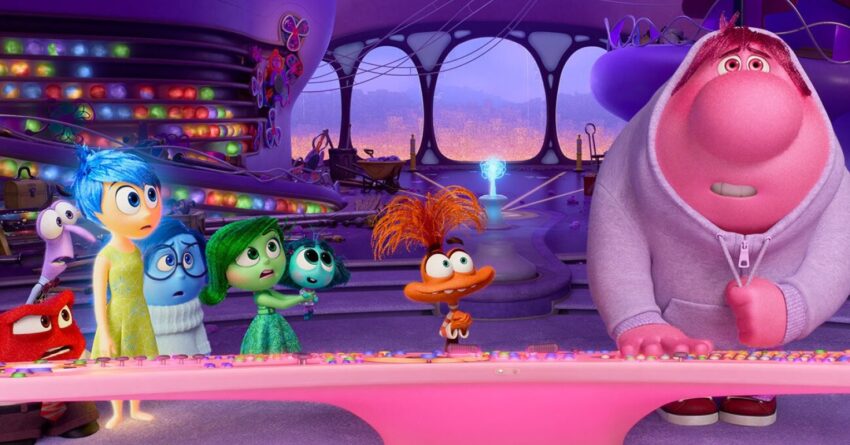One of the central themes of the Inside Out sequel is the adolescent transition through puberty, and in particular, the rise of new emotions such as anxiety, ennui, and embarrassment. Anxiety assumes a central role in the film, literally evicting the other primary emotions (joy, fear, disgust) in order to commandeer 13-year-old Riley’s journey through puberty.
The film offers several “teachable moments” about anxiety as an emotion, both developmentally in puberty as well as more broadly as both an aid and obstacle in adult functioning.
Anxiety Has a Logic
In the film, the character Anxiety takes over from the primary emotions and immediately begins planning for possible bad scenarios that could occur to adolescent Riley. In a massive control room, Anxiety predicts all kinds of possible mishaps, like missing a goal or being too forthright and enthusiastic with a teammate.
This is an important step in human development and has a natural and protective logic. By being mindful of future outcomes, Riley can make different and sometimes better choices to ensure a desired outcome.
In other words, anxiety tunes the individual into the future, connecting short-term or immediate actions with broader long-term goals. If Riley wants to develop close friendships with new girls on the team, for example, she should demonstrate an interest in them through their interests, such as music.
The film shows the emergence of anxiety as a “necessary evil” of the developmental process by revealing the naivety and self-obsessed nature of unbridled joy or pleasure. When Riley joins the hockey training camp, her emotion Joy assumes control of her actions, and Riley becomes over-concerned with her small group of friends, taking selfies and giggling.
This immediate pleasure-seeking goal disrupts the preliminary pep talk and distracts the team from the primary task at hand—getting better at hockey. Anxiety nudges Riley away from the narcissism of her immediate gratification toward the longer-term goal of achieving success as a player and succeeding with peers and mentors.
Anxiety Can Be a Form of Conscience
In this way, the film shows how anxiety can help us in part to become aware of realities and concerns outside of ourselves and prepare us for the consequences of our actions.
From this lens, we can see anxiety as part of a developmental step in learning about others and how to mitigate our pleasure-seeking for the sake of community and securing our place in it. While this may at first feel like a loss of freedom and agency, greater freedom may occur through the connection of being part of a larger team.
Anxiety Alone Cannot Run the Show
The film teaches us that anxiety alone cannot run the show.
Left unchecked, anxiety can sabotage the individual both in their actions and in their discreet mental health.
When Anxiety (the emotion) becomes fixed on making the team, it compromises Riley’s general sense of values by sneaking into the coach’s office and looking at her notes.
This scene shows how unchecked and unmanaged anxiety can override core beliefs and values of character in order to assuage anxiety’s fixated notions.
This is not uncommon in clinical situations, where unchecked anxiety can lead to intensive panics as well as obsessional and even risky actions. The worry about a partner’s actions can lead to secret surveillance and snooping, or money anxieties can lead to hoarding or self-denying and wounding actions like under-eating.
Managing Anxiety Through Emotional Integration
One of the solutions to unchecked anxiety offered in the film is the integration of other emotions, an integration that dilutes the power and strength of anxiety.
We see this at various points throughout the film. Joy is able to provide alternative possible outcomes that are positive and hopeful, lending new imaginary landscapes for anxiety to focus on.
Even Sadness can be an important corrective to unchecked anxiety. A crucial scene revolves around Riley remembering earlier core beliefs about herself, a remembering that is tinged by the sadness that comes inevitably from growing up.
Moving through developmental stages inevitably involves an element of sadness and loss as we lose parts of ourselves that are often special and dear to us. Riley, for instance, loses some of the naive joy that she experienced with her close friends as a result of reaching out and expanding her social circle.
This can sometimes be felt as anxiety as we venture into unknown waters. However, by integrating parts of the potential joy of the unknown—imagining new, joyful possibilities and retaining a positive memory of the past through nostalgic sadness—this anxiety can be held in check.
In this way, the film reproduces a core insight into anxiety. While anxiety can be crippling if left unchecked, learning to be anxious in the right way can help steer us toward natural developmental milestones by taking on appropriate risks, like entering new social spheres.
